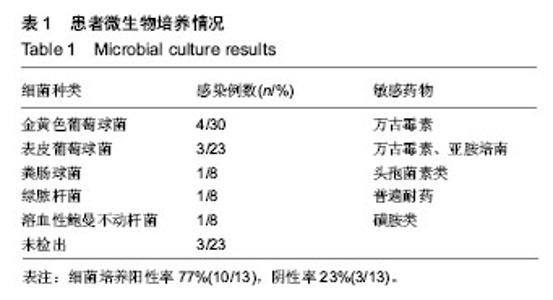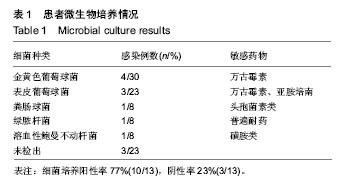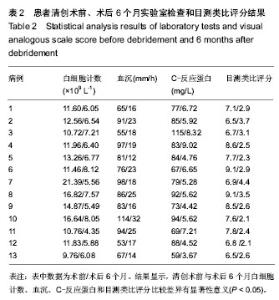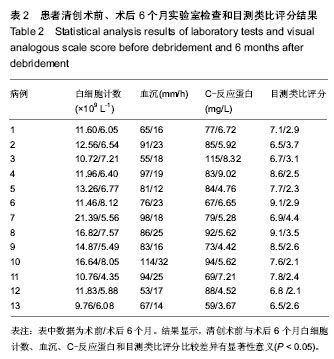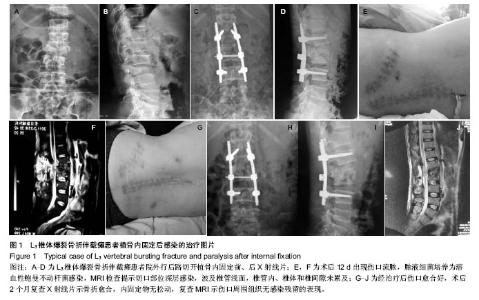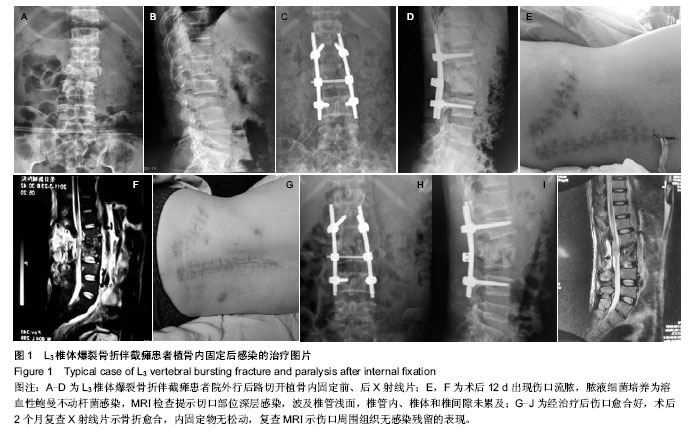Chinese Journal of Tissue Engineering Research ›› 2015, Vol. 19 ›› Issue (4): 537-542.doi: 10.3969/j.issn.2095-4344.2015.04.008
Previous Articles Next Articles
Treatment for thoracolumbar spine infection without removing internal fixation
Lin Xu, Tan Lun, Zeng Jun, Wu Chao, Ding Yong, Guo Yong
- Department of Orthopedics, the Fourth People’s Hospital of Zigong City, Zigong 643000, Sichuan Province, China
-
Revised:2014-11-25Online:2015-01-22Published:2015-01-22 -
Contact:Tan Lun, Master’s supervisor, Chief physician, Department of Orthopedics, the Fourth People’s Hospital of Zigong City, Zigong 643000, Sichuan Province, China -
About author:Lin Xu, M.D., Associate chief physician, Department of Orthopedics, the Fourth People’s Hospital of Zigong City, Zigong 643000, Sichuan Province, China
CLC Number:
Cite this article
Lin Xu, Tan Lun, Zeng Jun, Wu Chao, Ding Yong, Guo Yong. Treatment for thoracolumbar spine infection without removing internal fixation [J]. Chinese Journal of Tissue Engineering Research, 2015, 19(4): 537-542.
share this article
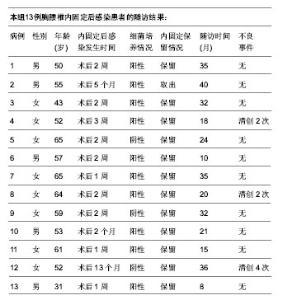
2.1 参与者数量分析 按意向性处理,自贡市第四人民医院骨科自2008年3月至2012年12月共进行胸腰椎内固定手术358例,术后发生早期和晚期感染共13例,所有病例均完成治疗并获得随访,无脱落。 2.2 随访结果 本组感染患者的分泌物细菌培养阳性10例(77%),阴性3例(23%),患者感染均获治愈。12例内固定物成功保留,1例T12骨折取出内固定后治愈。随访时间8-40个月,无复发病例。 2.3 实验室检查和随访结果 记录患者清创引流术前术后6个月的血液分析、血沉、C-反应蛋白和疼痛目测类比评分。微生物培养情况、实验室检查和目测类比评分随访统计结果见表1,2。 2.4 典型病例 见图1。 2.5 不良事件 本组有2例内固定后深部感染患者,清创引流后,引流液浑浊,培养仍有细菌,再次行清创、冲洗引流治愈。1例T12椎体霍奇金淋巴瘤患者内固定后13个月发生迟发性深部感染,分泌物多次细菌培养阴性,经过4次清创、冲洗引流,伤口迁延不愈。取组织病检,提示慢性炎症,可见干酪样变和不典型朗罕式细胞,结核菌素试验为强阳性,抗痨治疗后伤口逐渐愈合。"
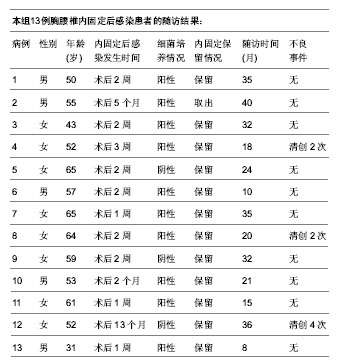
| [1] Pull ter gunne AF, Cohen DB. Incidence, prevalence, and analysis of risk factors for surgical site infection following adult spinal surgery. Spine (Phila Pa 1976). 2009;34(13): 1422-1428. [2] Rayes M, Colen CB, Bahgat DA, et al. Safety of instrumentation in patients with spinal infection. J Neurosurg Spine. 2010;12(6):647-659. [3] 林青松,钟招明,陈建庭.脊柱手术后切口感染的危险因素[J]. 实用医学杂志,2014,30(10):587-1590. [4] 屈伟俊,孙建军,李跃红.脊柱手术后切口感染的危险因素研究[J]. 中华医院感染学杂志, 2013, 23(9):2105-2106. [5] Hayashi H, Murakami H, Demura S, et al. Surgical site infection after total en bloc spondylectomy: risk factors and the preventive new technology. Spine J. 2014. [6] Bas T, Bas P, Blasco A, et al. Chronic infections of the spine. Eur J Orthop Surg Traumatol, 2013, 23 Suppl 1(S35-40. [7] 李若愚,车武,董健.脊柱术后手术部位感染的治疗进展[J]. 中国脊柱脊髓杂志, 2012, 22(4):366-369. [8] 魏军渔.脊柱术后急性感染的治疗策略探讨[J]. 脊柱外科杂志, 2014, 12(4):208-211. [9] Collins I, Wilson-macdonald J, Chami G, et al. The diagnosis and management of infection following instrumented spinal fusion. Eur Spine J. 2008;17(3):445-450. [10] Ho C, Skaggs DL, Weiss JM, et al. Management of infection after instrumented posterior spine fusion in pediatric scoliosis. Spine (Phila Pa 1976). 2007;32(24):2739-2744. [11] Cahill PJ, Warnick DE, Lee MJ, et al. Infection after spinal fusion for pediatric spinal deformity: thirty years of experience at a single institution. Spine (Phila Pa 1976). 2010;35(12): 1211-1217. [12] Alpert HW, Farley FA, Caird MS, et al. Outcomes following removal of instrumentation after posterior spinal fusion. J Pediatr Orthop. 2014;34(6):613-617. [13] Fang XT, Wood KB. Management of postoperative instrumented spinal wound infection. Chin Med J (Engl). 2013;126(20):3817-3821. [14] Ishii M, Iwasaki M, Ohwada T, et al. Postoperative deep surgical-site infection after instrumented spinal surgery: a multicenter study. Global Spine J. 2013;3(2):95-102. [15] Kim JI, Suh KT, Kim SJ, et al. Implant removal for the management of infection after instrumented spinal fusion. J Spinal Disord Tech. 2010;23(4):258-265. [16] Dubee V, Lenoir T, Leflon-guibout V, et al. Three-month antibiotic therapy for early-onset postoperative spinal implant infections. Clin Infect Dis. 2012;55(11):1481-1487. [17] 曹海云.脊柱手术后并发感染的原因及处理[J].中国实用医药, 2011, 6(25):119-120. [18] Glotzbecker MP, Riedel MD, Vitale MG, et al. What's the evidence? Systematic literature review of risk factors and preventive strategies for surgical site infection following pediatric spine surgery. J Pediatr Orthop. 2013;33(5): 479-487. [19] Goni V, Bahl A, Gopinathan NR, et al. Iatrogenic aortic pseudoaneurysm following anterior thoracic spine surgery masquerading as chronic infection. Chin J Traumatol. 2013;16(6):368-370. [20] Chen SH, Lee CH, Huang KC, et al. Postoperative wound infection after posterior spinal instrumentation: analysis of long-term treatment outcomes. Eur Spine J. 2014. [21] Mok JM, Guillaume TJ, Talu U, et al. Clinical outcome of deep wound infection after instrumented posterior spinal fusion: a matched cohort analysis. Spine (Phila Pa 1976).2009;34(6): 578-583. [22] 庄泽民,李强.胸椎骨折术后感染经皮固定器治疗一例[J].中国骨与关节损伤杂志,2011, 26(8):713. [23] Nunez-pereira S, Pellise F, Rodriguez-pardo D, et al. Implant survival after deep infection of an instrumented spinal fusion. Bone Joint J. 2013;95-B(8):1121-1126. [24] Takahashi J, Shono Y, Hirabayashi H, et al. Usefulness of white blood cell differential for early diagnosis of surgical wound infection following spinal instrumentation surgery. Spine (Phila Pa 1976). 2006;31(9):1020-1025. [25] Cyteval C, Bourdon A. Imaging orthopedic implant infections. Diagn Interv Imaging. 2012;93(6):547-557. [26] 何鱼,权正学.脊柱手术术后感染防治中抗菌药物的应用[J].重庆医学, 2012, 41(35):3772-3774. [27] Kasliwal MK, Tan LA, Traynelis VC. Infection with spinal instrumentation: Review of pathogenesis, diagnosis, prevention, and management. Surg Neurol Int. 2013; 4(Suppl 5):S392-403. [28] Miksic NG. Spinal infections with and without hardware: the viewpoint of an infectious disease specialist. Eur J Orthop Surg Traumatol. 2013;23 Suppl 1:S21-28. [29] Yano MH, Klautau GB, Da silva CB, et al. Improved Diagnosis of Infection Associated to Osteosynthesis by Use of Sonication of Fracture-Fixation Implants. J Clin Microbiol. 2014. [30] Bemer P, Corvec S, Tariel S, et al. Significance of Propionibacterium acnes-positive samples in spinal instrumentation. Spine (Phila Pa 1976). 2008;33(26): E971-976. [31] Barrey C, Launay O, Freitas E, et al. The follow-up of patients with postoperative infection of the spine. Eur J Orthop Surg Traumatol. 2013;23 Suppl 1:S29-34. [32] Messina AF, Berman DM, Ghazarian SR, et al. The management and outcome of spinal implant-related infections in pediatric patients: a retrospective review. Pediatr Infect Dis J. 2014;33(7):720-723. [33] Li H, Hamza T, Tidwell JE, et al. Unique antimicrobial effects of platelet-rich plasma and its efficacy as a prophylaxis to prevent implant-associated spinal infection. Adv Healthc Mater. 2013;2(9):1277-1284. [34] Kato S, Hozumi T, Yamakawa K, et al. Antibiotic-impregnated cement embedding technique for spinal instrumentation infections. J Neurol Surg A Cent Eur Neurosurg. 2014;75(6): 479-484. [35] Ferry T, Valour F, Lustig S, et al. The challenge of infection prevention in spine surgery: an update. Eur J Orthop Surg Traumatol. 2013;23 Suppl 1:S15-19. |
| [1] | Chen Qun-qun, Qiao Rong-qin, Duan Rui-qi, Hu Nian-hong, Li Zhao, Shao Min. Acu-Loc®2 volar distal radius bone plate system for repairing type C fracture of distal radius [J]. Chinese Journal of Tissue Engineering Research, 2017, 21(7): 1025-1030. |
| [2] | Zou Wei, Xiao Jie, Long Hao, Zhang Yang, Wu Chen, Du Yu-hui, Feng Ming-xing, Zhou Chang-jun. Screw placement selection of minimally invasive percutaneous pedicle screw fixation for thoracolumbar fractures [J]. Chinese Journal of Tissue Engineering Research, 2017, 21(3): 356-361. |
| [3] | Chen Lu-yao, Hu Shi-qiang, Wang Xiao-ping, Wu Wei-wei, Wei Zhan-tu, Huang Jian. Accuracy of digital orthopedic three-dimensional reconstruction for thoracolumbar pedicle screw placement [J]. Chinese Journal of Tissue Engineering Research, 2017, 21(3): 373-377. |
| [4] | Du Shi-yao, Zhou Feng-jin, Ni Bin, Chen Bo, Chen Jin-shui. Finite-element analysis of a novel posterior atlantoaxial restricted non-fusion fixation system [J]. Chinese Journal of Tissue Engineering Research, 2017, 21(3): 383-389. |
| [5] | Liu Jun, Liao Su-ping. Three-dimensional finite element analysis of Kirschner nails and external fixation for Bennett fracture [J]. Chinese Journal of Tissue Engineering Research, 2017, 21(3): 390-395. |
| [6] | Sheng Xiao-lei, Yuan Feng, Li Zhi-duo, Yang Yu-ming, Lu Hai-tao, Zhang Jun-wei. Comparison of the accuracy of lower cervical anterior transpedicular screws between three-dimensional printing assembly navigation template and free hand placement [J]. Chinese Journal of Tissue Engineering Research, 2017, 21(3): 406-411. |
| [7] | Wu Min-hao, Sun Wen-chao, Yan Fei-fei, Xie Yuan-long, Hou Zhi-qiang, Feng Fan, Cai Lin . Treatment research and new progress of early-onset scoliosis [J]. Chinese Journal of Tissue Engineering Research, 2017, 21(3): 433-439. |
| [8] | Wang Lei, Wang Feng-feng, Ma Yan-hui, Zhang Jie, Hu Fang, Ma Gai-ping, Liu Mei-mei, Ma Zhang-wen. Meta analysis of clinical outcome of intramedullary nails versus locking plates for two-part proximal humerus fracture [J]. Chinese Journal of Tissue Engineering Research, 2017, 21(3): 478-484. |
| [9] | Hu Jun, Zhang De-qiang, Tang Xin. Postoperative quality of life of internal fixation versus hemiarthroplasty for femoral neck fractures in the elderly [J]. Chinese Journal of Tissue Engineering Research, 2017, 21(19): 2953-2960. |
| [10] | Jiang Wei, Yuan Feng. Unilateral pedicle screw fixation combined with translaminar facet screw fixation versus bilateral pedicle screw fixation for lower lumbar degenerative diseases: a 2-year follow-up [J]. Chinese Journal of Tissue Engineering Research, 2017, 21(19): 2973-2979. |
| [11] | Wang Xiu-ping, Sun Rui-bo, Liu You-wen, Zhang Ying, Jia Yu-dong, Yang Yu-xia, Wang Hui-chao. Femoral neck fractures fixed with intramedullary cannulated screws: factors for postoperative functional recovery [J]. Chinese Journal of Tissue Engineering Research, 2017, 21(19): 2999-3004. |
| [12] | Liu Gang, Zhang Lei, Wang Guo-you, Zhou Xin, Zhang Tao, Guan Tai-yuan, Guo Xiao-guang, Fu Shi-jie. Double-row suture anchors under arthroscopy for avulsion-type greater tuberosity fractures (Mutch type I) [J]. Chinese Journal of Tissue Engineering Research, 2017, 21(19): 3005-3010. |
| [13] | Yang Min, Ma Xiang-yang, Yang Jin-cheng, Chen Shu-jin, Zou Xiao-bao. Biomechanical properties of a novel automatic anti-rotation posterior atlantoaxial internal fixation system: a finite element analysis [J]. Chinese Journal of Tissue Engineering Research, 2017, 21(19): 3031-3037. |
| [14] | Qiu Hao, Lu Min-peng, Dong Jing, Zhang Zhong-zu, Chu Tong-wei, Wang Qun-bo, Quan Zheng-xue, Jiang Dian-ming. Subtotal corpectomy and reconstruction with titanium mesh cage implantation and pedicle screw fixation through posterior approach in treatment of thoracolumbar burst fracture or thoracolumbar fracture dislocation [J]. Chinese Journal of Tissue Engineering Research, 2016, 20(53): 7932-7938. |
| [15] | Wang Hua-jin, Zhang Jian, Sheng Wei-bin. Lumbar unilateral and bilateral interbody fusion with internal fixation versus non-internal fixation for treating lumbar disc herniation [J]. Chinese Journal of Tissue Engineering Research, 2016, 20(53): 7939-7945. |
| Viewed | ||||||
|
Full text |
|
|||||
|
Abstract |
|
|||||
